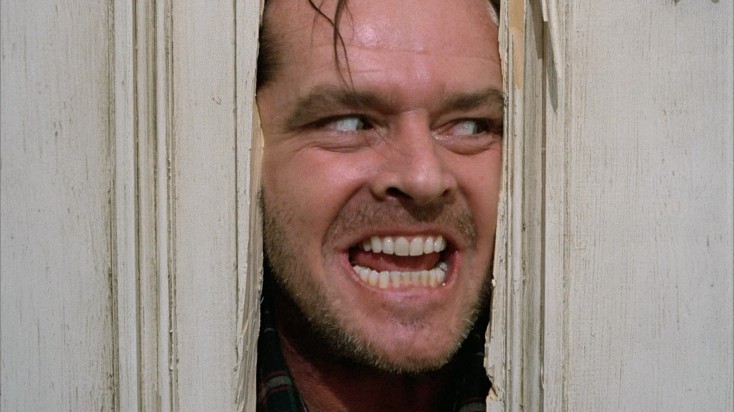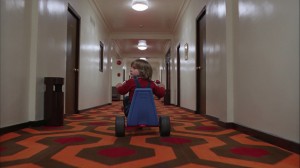By ANGELA DAWSON
Front Row Features
HOLLYWOOD—It’s been more than 30 years since the release of Stanley Kubrick’s “The Shining,” yet this horror film, adapted from a Stephen King novel, continues to fascinate audiences. For some, “The Shining,” which starred Jack Nicholson and Shelley Duvall as a couple, who become caretakers for an isolated mountainside hotel and, along with their precocious son Danny (Danny Lloyd), are soon haunted by its ghostly inhabitants, has become an obsession.
In the documentary “Room 237,” a reference to a particularly scary room at the Overlook, five theorists offer their views on the meaning of the 1980 film. A history professor, for example, says the film alludes to the horrors of the Holocaust, by pointing out that multiplying the individual digits of the room number (2 x 3 x 7) equals 42, a reference to the 1942 beginning of the Nazis’ “Final Solution.” Another expert (ABC News correspondent Bill Blakemore) sees the film as an indictment of the white man’s policy of genocide against Native Americans.Theatrically released earlier this year, the documentary is available at SundanceNOW (http://www.sundancenow.com/film/room-237/1070).
Director Rodney Ascher and producer Tim Kirk spoke in March at length about “Room 237” and their own theories about why people are still obsessed with this cinema classic three decades after it first hit theaters.
Q: Why do you think “The Shining” has generated so many theories about what it means?
Ascher: It is really a puzzle that’s missing a few pieces. Even at the simplest level of story, there are huge gaps in what we know about what goes on in it. The central event in the film, what happens to Danny in Room 237, is never explained, let alone shown. That black and white photo at the end of (the film) was presented as if it was the answer to some kind of puzzle that we had all along, but if anything, it’s an entirely new question about what’s happening in the film. I think people are attracted to watch it and re-watch it to try to solve those sorts of puzzles, and then they find all these new ones.
Q: How does it differ from other horror films?
Ascher: A lot of movies end by giving you the shock answer of what happens that explains everything, and in a way, you can leave satisfied. “Shutter Island” is a really interesting movie, but the twist ending in that movie puts everything into perspective and you kind of get it. With “The Shining,” you never quite get it. It’s troubling because it seems on the surface a very simple story of three people in a hotel over the winter and they start to see ghosts, and trying to find the point where it kind of breaks up is endlessly complicated. It’s also a horror movie that’s a fun, entertaining film, so people watch it just because they want to watch it and not like it’s a homework assignment like a more difficult, challenging art film might be. When they find things that don’t add up, they’re compelled to re-watch it.
Q: This film was such a departure from what Kubrick had done previously, plus he linked up with Stephen King, a populist novelist. Do you think people are just trying to figure out why he would do this?
Kirk: I think so, and I think that people who are familiar with Kubrick and his other films are interested to see him do a take on that kind of film in a new genre. He was a genre filmmaker (and yet) just because he was known to be so meticulous and such a perfectionist in the multiple takes and so forth, I think there’s this feeling that if there’s anything in the frame, he put it there and there’s a reason, and that reason can be determined.
Ascher: And if you don’t understand something, it’s not his mistake. It’s your problem.
Q: Have you had a reaction from Stephen King to “Room 237?”
Ascher: Not yet. But he’s one of the people I’m most interested to get a reaction.
Q: In the film, someone says Kubrick had an IQ of 200, which is past genius. How did you find out about that?
Kirk: That’s actually Jay Weidner, the person we interviewed, saying that. Fact checking wasn’t a major part of our film, and I mean that in a positive way.
Ascher: This is not a hard-core behind-the-scenes film. This is what are people saying about “The Shining,” and how they are struggling to make sense of this problem that’s been dumped in their lap.
Kirk: Before we interviewed anyone, one of the decisions we made was that we weren’t going to talk to people that worked on the film. It wasn’t going to be a behind-the-scenes or here’s the answer (documentary). As much as we would love to know, it didn’t seem appropriate as the filmmakers to decide. Kubrick puts things in there for a reason because he wants to catch your eye. That seems to come across in all of his films since “Paths of Glory,” where you have that entire long shot of the battle that just keeps going.
Ascher: He’s always been a filmmaker who’s done things exactly to his own vision. So, there is more reason to assume that unusual choices and small details in a Kubrick film are more intentional than you might assume with another filmmaker.
Q: There are so many different conspiracy theories that you guys delve into. Some of them make complete sense while others are completely outlandish. What is the most outlandish or over the top thing that heard?
Ascher: That “The Shining” is the story of three people trapped in a hotel over the winter and they see ghosts. (He chuckles.)
Q: Was there anything you rejected because it was too outlandish?
Kirk: There were people we wanted to interview that we couldn’t for one reason or another. But I don’t think outlandish was ever a yardstick. I think it was more if it was less persuasive or didn’t grab us in some way or another.
Ascher: Outlandish is a hard thing to dismiss when you’re talking about a symbolic interpretation of a horror movie that’s drawing on things like Freud’s sense of the uncanny.
Q: Once you guys developed these four or five main theories that drive the film, why did you just have one voice represent them instead of a compilation of people who also support those same theories?
Ascher: I think it was about wanting to dive deeper down fewer holes and not assemble something that’s a thousand sound bites, but to kind of let someone take the time to lay the groundwork and expand on it.
Q: What was your thinking behind not showing the faces the theorists?
Ascher: It was a style that I started with a short film (“The S From Hell”) that I had done a year or two earlier which worked in some interesting and unexpected ways. I may have started it in that project because it was a no budget, personal 10-minute film, but it did a lot of things that I was really interested in, not the least of which was when I didn’t have a talking head shot to go back to, I would have to struggle harder to find imagery to illustrate these ideas. Sometimes it would be very, very literal, but other times it would open up the door to using something subjectively that would be kind of interesting and would stretch the original intention of the footage in a cool way. Also, stylistically, sometimes when you see the talking head shot, it’s like coming up for breath or coming down for a landing and it’s like, “Okay, now we’re back in reality and then we’re going to go into the montage.” I just wanted to stay in that dreamlike world of ideas and pictures and let the movie take place in outer space and the Old West and not somebody’s office or a hotel room or living room.
Q: Do you think there’s a tendency to see Kubrick as infallible when some of the things that were highlighted in the movie might simply be continuity errors given the convoluted and lengthy production process of the actual movie?
Kirk: I think for sure there is a tendency to think of him as infallible.
Ascher: He does have a pretty good track record going into “The Shining.” He had more personal control over the details of his films than other folks. You’re not the first person to suggest that some of those continuity issues might have just been errors, but there sure were a lot of them. I can’t believe all of them were. Coming from one of the most accomplished filmmakers of all time, if you see something that looks like an accident at first glimpse, there’s at least a reason to consider it and say, “Is that really an accident?”
Q: Do you think that at some point your film might be dissected the same way? Like your use of Tom Cruise (from a scene in Kubrick’s “Eyes Wide Shut”) at the very beginning?
Kirk: I hope so. It’s interesting. I have a 5-year-old daughter, and she’s very interested in what I’m doing, so she really wants to see “The Shining,” and that’s not going to happen. But some day she will, and she’ll see it in a world where “Room 237” exists, and she knows that people think about this including her dad. I just can’t even get into my head that second generation or third generation viewing of “The Shining” or “Room 237.”
Q: What was the one thing that maybe somebody said that really stuck with you or that opened your eyes to a whole new set of theories?
Kirk: First of all, I could listen to (ABC News’) Bill Blakemore talk for eight hours straight. He’s a really compelling guy. But there was one. I just remember reading Jay’s essay early in the process and being maybe a little dismissive about the moon landing thing. And then, I got to this part where he was talking about if Jack (Nicholson) represents the caretaker of the hotel for the Apollo missions, the previous caretaker would be representing the previous program from NASA and it was Gemini, which are twins, and Grady (Philip Stones) had twins. I just remember my hand shaking. I had a couple of those kind of moments during this film, but that one still stands out to me as the one where I kind of left my body for a little while.






